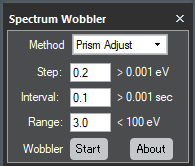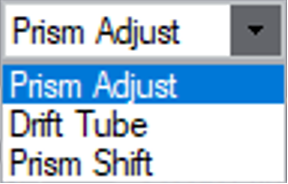The signal-to-noise ratio (SNR) of the spectral feature can be improved by accumulating many spectra. However, if the spectra are accumulated so many times, the channel variations of the gain and/or dark current will show up, and limit the attainable SNR.
This plug-in shifts (wobbles) the spectrum on the detector during acquisition of a set of spectra, especially a spectrum imaging (SI). When the set of spectra is accumulated after adjusting the spectrum shift, the channel variations will be reduced, and the SNR will be improved further.
Spectrum Wobbler plug-in is provided by HREM Research Inc. and freely downloaded.

DISCLAIMER: Please use this plug-in entirely at your own risk. We will not accept any responsibility for any losses or damage which may arise from its use.
スペクトル移動手法

The Prism Adjust will control the prism setting, and work, even when the drift correction during the MFSI (multi-frame spectrum imaging) acquisition adjusts the zero-loss position in addition the scanning area. Thus, the Prism Adjust will work well for the PEELS as well as the DualEELS.
The Drift Tube will control the drift tube setting, and wobble the spectrum of the regular PEELS, or only the high-loss spectrum of the DualEELS.
使用法
Copy the files to DM Plug-Ins folder, and then launch the DM again.
- The Spectrum Wobbler will appear in the sub menu of Floating Windows under Window menu.
- Select the Spectrum Wobbler from the Floating Windows sub menu to open the tool palette.
- Start the Spectrum Wobbler before acquiring an SI data, and stop the Wobbler after data acquisition.
- The obtained spectrum should be adjusted by yourself using cross-correlation of the spectrum feature or the zero-loss shift of the low-loss spectrum in the case of DualEELS.
推奨設定
The Spectrum Wobbler will work asynchronously with the spectrum acquisition. The spectrum will be blurred when the spectrum is shifted more than the energy resolution during the exposure time. Therefore, the following inequality should be hold:
energy shift step (eV) x (exposure time/interval) < energy resolution (eV)
Usually, the energy resolution is several times of the channel energy width (dispersion: eV/channel). Therefore, the total spectrum shift during the acquisition time may be set to the channel energy width or a fraction of it.
Step: an energy shift step (in eV). e.g. 0.2 x channel energy (dispersion: eV/channel). Interval: an interval of the energy shift (in sec). e.g. 0.5 x exposure time of each spectrum.
The above Step (0.2 x channel energy) and Internal (0.5 x exposure time) results in the energy uncertainty of 0.4 channel during the exposure time.
Range: the maximum energy shift (in eV).
ダウンロード
for GMS 3.3 (64bit)*
for GMS 3.2 (64bit)* (applicable from GMS 3.0)
for GMS 2.3 32bit GMS 2.3 64bit
for GMS 2.1 32bit GMS 2.1 64bit (applicable from GMS 2.0)
文献、技術資料
- V.D. Hou: Reduce Correlated Noise in EELS Spectrum with High Quality Dark Reference, Microsc. Microanal 15 (S2) (2009) 226–227.
- M. Haruta, Y. Fujiyoshi, T. Nemoto, A. Ishizuka, K. Ishizuka, H. Kurata: Extremely low count detection for EELS spectrum imaging by reducing CCD read-out noise, Ultramicroscopy 207 (2019) 112827
HREM ニュース
このプラグインに関する情報をお知らせ致しますのでHREM Newsにご登録下さい。
注意:一度HREM Newsに登録された方は再度登録の必要はありません。